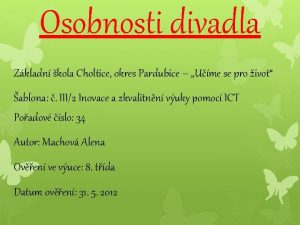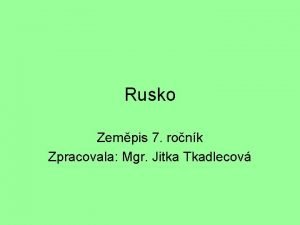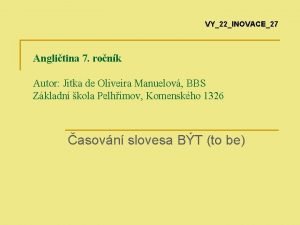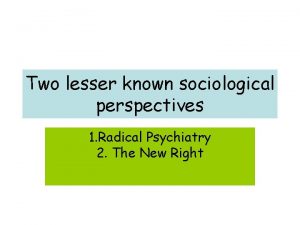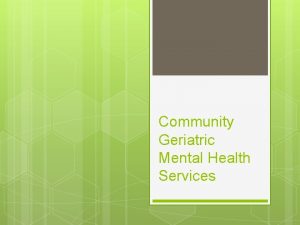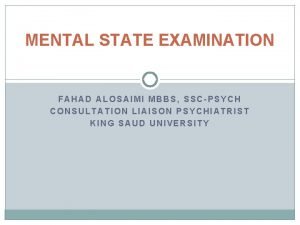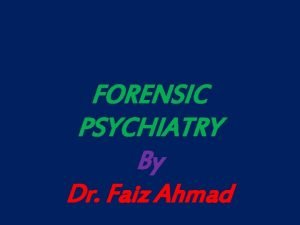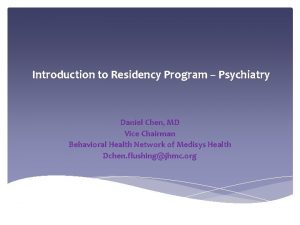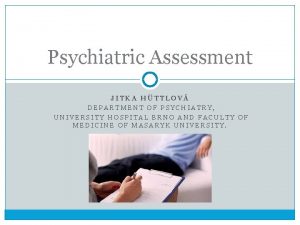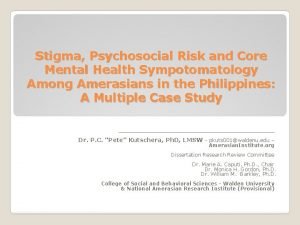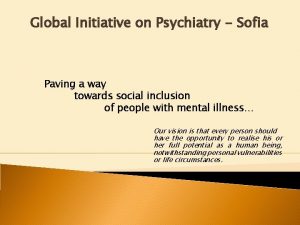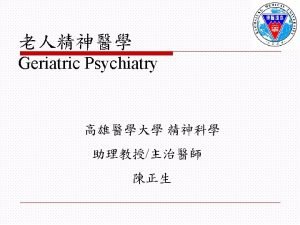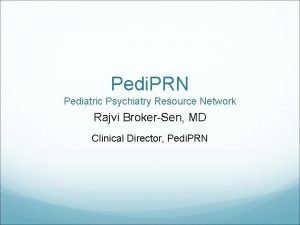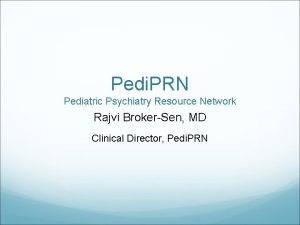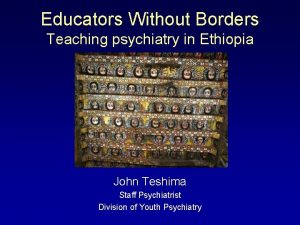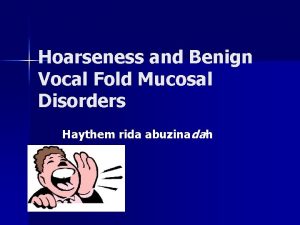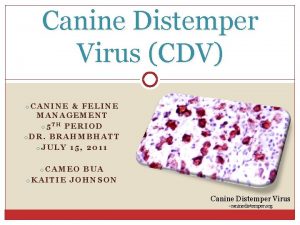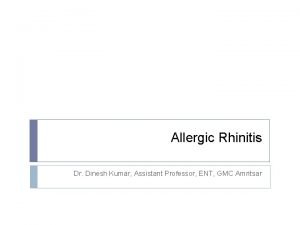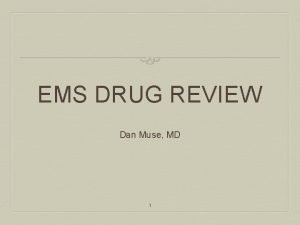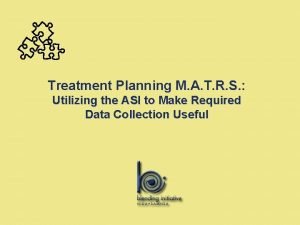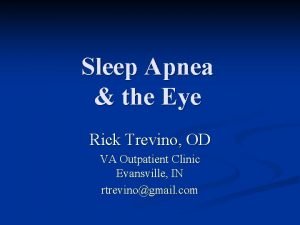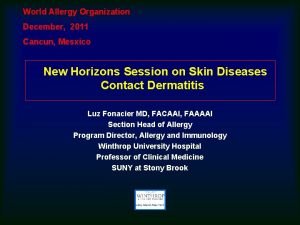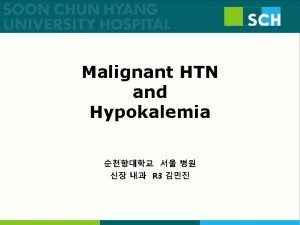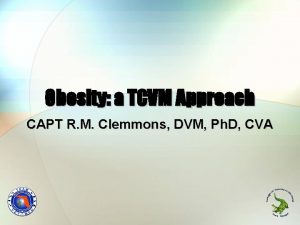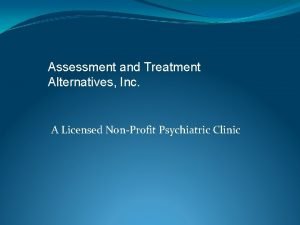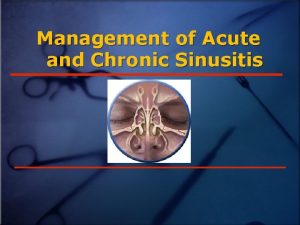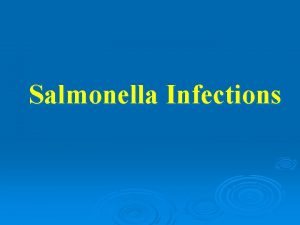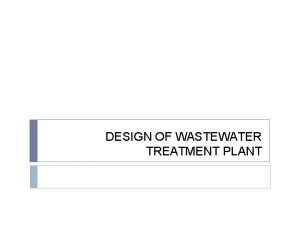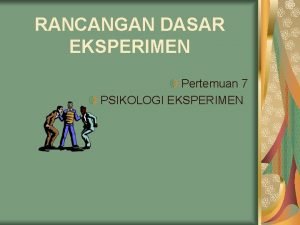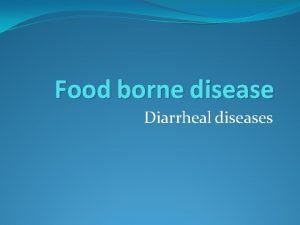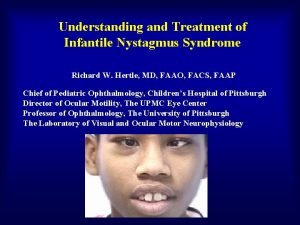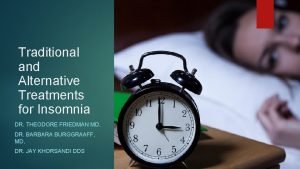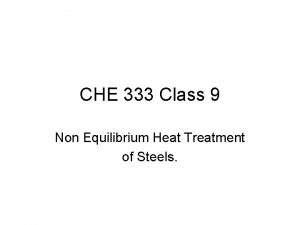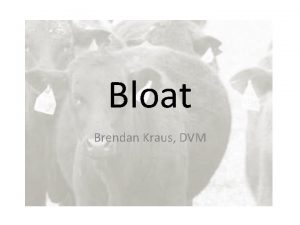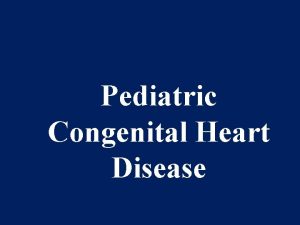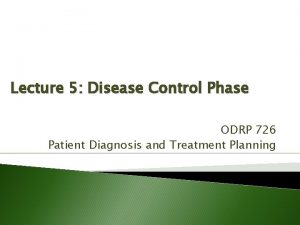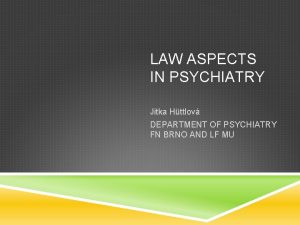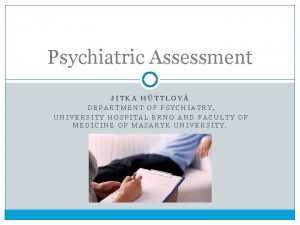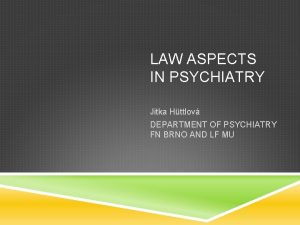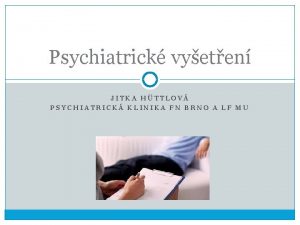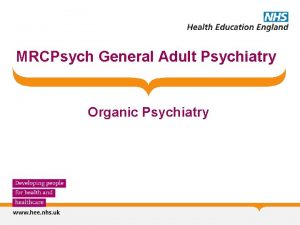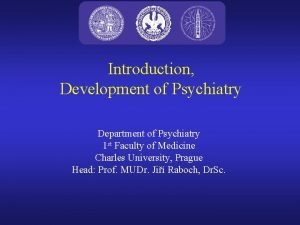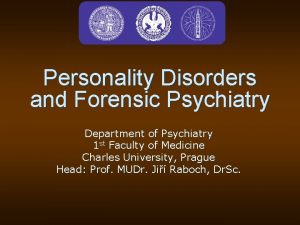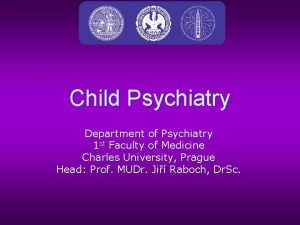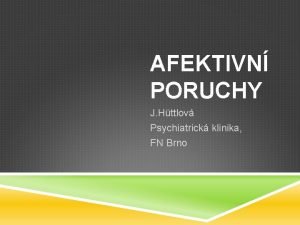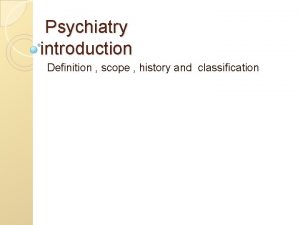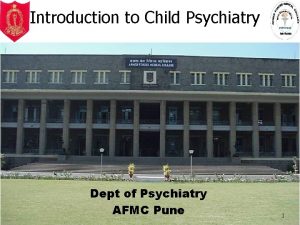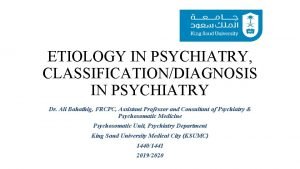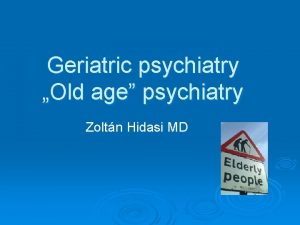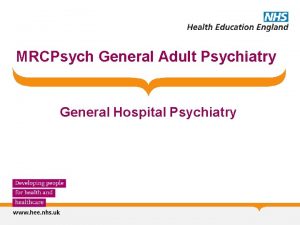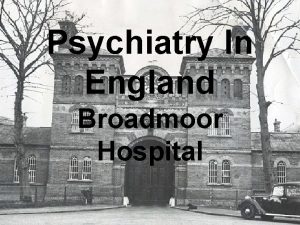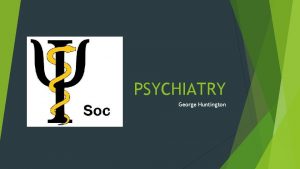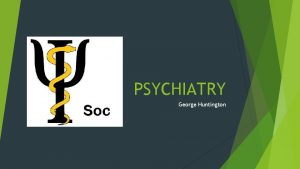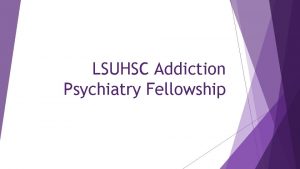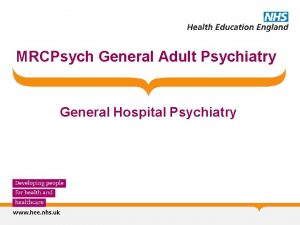Treatment in Psychiatry Jitka Httlov Department of Psychiatry













































- Slides: 45

Treatment in Psychiatry Jitka Hüttlová Department of Psychiatry, University Hospital Brno and Faculty of Medicine of Masaryk University

Treatment in Psychiatry A. BIOLOGICAL treatment Psychopharmacotherapy Electroconvulsive Therapy (ECT) Repetitive Transcranial Magnetic Stimulation (r. TMS) Deep Brain Stimulation (DBS) Vagus Nerve Stimulation Light Therapy B. PSYCHOSOCIAL treatment Psychotherapy Psychiatric rehabilitation Other (music therapy, art therapy, ergotherapy…)

Psychopharmacotherapy Main Psychopharmacological Drugs 1. Antidepressants 2. Mood stabilizers 3. Antipsychotics 4. Anxiolytics 5. Hypnotics 6. Cognition-Enhancing Drugs 7. Psychostimulants

1. Antidepressants General guidelines for antidepressant use Antidepressant efficacy is very similar so selection is based on past history of a response, side effect profile and coexisting medical conditions. There is a delay typically of 2 -4 weeks after a therapeutic dose is achieved before symptoms improve. If no improvement is seen after a trial of adequate length and adequate dose, either switch to another antidepressant or augment with another agent.

1. Antidepressants Neurobiology of monoamine neurotransmitters → depression Increase in monoamine neurotransmitters → treatment of depression Lack (Stahl 1997)

1. Antidepressants Neurotransmitter Reuptake Inhibition and Binding Affinity to Receptors

Classification Name Example st generation Tricyclics (TCAs) and tetracyclics (Te. CAs) amitriptyline clomipramine 2 nd generation 3 rd generation 4 th generation Other viloxazine SSRI (Selective Serotonin Reuptake Inhibitors ) citalopram escitalopram sertralin SARI (Serotonin antagonist and reuptake inhibitor) trazodon NRI (Nor-Adrenaline Reuptake inhibitors) reboxetin SNRI (Serotonin/Norepinephrine reuptake inhibitors) venlafaxine milnacipran DNRI (Dopamine/Norepinephrine reuptake inhibitors bupropione Blockators of α 2 -adrenoceptors mirtazapin mianserin (MAOIs) Monoamine Oxidase Inhibitors moclobemide selegiline

Classification Name Mechanism of Therapeutic Efficacy Specific character Examples 1 st generation • Inhibition of Serotonin and/or Norepinephrine reuptake followed by increase of their concentrations in synaptic cleft (react with other types of receptors → more side effects) • Severe side effects antihistaminic (sedation, weight gain), anticholinergic (dry mouth, constipation, potentially delirium), antiadrenergic (orthostatic hypotension, sexual dysfunction) • Can cause dangerous QT lengthening • Danger of Intoxication • Many Interactions amitriptyline nortriptyline clomipramine dosulepin Tricyclics (TCAs) and tetracyclics (Te. CAs)

Classification Mechanism of Therapeutic Efficacy Specific character Examples 2 nd generation Norepinephrine Reuptake Inhibition • Less anticholinergic side effects then 1 st generation viloxazine

Classification Name Mechanism of Therapeutic Efficacy Specific character Examples 3 rd generation SSRI (Selective Serotonin Reuptake Inhibitors ) Block the presynaptic serotonin reuptake • The most commonly used • Side effects: GI upset, sexual dysfunction, anxiety, restlessness, insomnia, fatigue or sedation, dizziness • Very little risk of cardiotoxicity in overdose citalopram escitalopram sertralin fluoxetin fluvoxamin paroxetin

Classification Name Mechanism of Therapeutic Efficacy Specific character Examples 3 rd generation SARI (Serotonin antagonist and reuptake inhibitor) Antidepressants with Doubled Serotonergic Efficacy • A risk of serotonin syndrome trazodon NRI (Selective Nor. Adrenaline Reuptake inhibitors) Increase norepinephrine reboxetin

Classification Name Mechanism of Therapeutic Efficacy Specific character Examples 4 th generation SNRI (Serotonin/No repinephrine reuptake inhibitors ) Inhibit both serotonin and noradrenergic reuptake • Side effects: venlafaxine nauzea, milnacipran dizziness, blood preasure increase DNRI (Dopamine/No repinephrine reuptake inhibitors) Inhibit Dopamine and Norepinephrine reuptake • No weight gain, no sexual side effects, no sedation or cardiac interactions bupropione

Classification Name other Mechanism of Therapeutic Efficacy Specific character Blockators of α 2 Increasing • Side effects: -adrenoceptors Synthesis and Weight gain, Releasing of sedation, Norepinephrine, Blockade Alpha-2 Adrenoceptors on Serotonergic Neurons and Increasing Production and Releasing of Serotonin Examples mirtazapin mianserin

Classification Name Mechanism of Therapeutic Efficacy Specific character Other Bind irreversibly to monoamine oxidase thereby preventing inactivation of biogenic amines such as norepinephrine, dopamine and serotonin leading to increased synaptic levels. • Side effects: moclobemide weight gain, dry selegiline mouth, sedation, sexual dysfunction and sleep disturbance • Hypertensive crisis can develop when MAOI’s are taken with tyramine-rich foods or sympathomimet ics (MAOIs) Monoamine Oxidase Inhibitors Examples

Psychopharmacotherapy Main Psychopharmacological Drugs 1. Antidepressants 2. Mood stabilizers 3. Antipsychotics 4. Anxiolytics 5. Hypnotics 6. Cognition-Enhancing Drugs 7. Psychostimulants

2. Mood stabilizers Indications: Bipolar, cyclothymia, schizoaffective, impulse control and intermittent explosive disorders. Classes: Lithium, anticonvulsants, antipsychotics Which you select depends on what you are treating and again the side effect profile.

Classification Example Characteristics Lithium • Only medication to reduce suicide rate • I: Effective in long-term prophylaxis of both mania and depressive episodes • SE: Thyroid abnormalities, Polyuria/polydypsia , intention tremor • BS: examination of renal, cardiac and thyreoidal function, pregnancy Antiepil. 2 nd generation carbamazepine • I: acute mania and mania prophylaxis • SE: Rash, nauzea, vomiting, drug interactions!!! • BS: baseline liver function tests, CBC and an EKG salts of valproic acid • I: as effective as Lithium in mania prophylaxis but is not as effective in depression prophylaxis Effective in dysforic mania • SE: Thrombocytopenia and platelet dysfunction, transaminitis, sedation • BS: liver function, CBC, pregnancy lamotrigine • I: Also used for neuropathic/chronic pain • SE: Nausea/vomiting, dizziness, toxic epidermal necrolysis and Stevens Johnson's Syndrome BS: liver function Antiepil. 3 rd generation gabapentine

Psychopharmacotherapy Main Psychopharmacological Drugs 1. Antidepressants 2. Mood stabilizers 3. Antipsychotics 4. Anxiolytics 5. Hypnotics 6. Cognition-Enhancing Drugs 7. Psychostimulants

3. Antipsychotics Neurobiology Excess of DOPAMINE → schizophrenia Decrease in Dopamine → treatment of schizophrenia

3. Antipsychotics Neurobiology MESOCORTICAL- associated with negative and cognitive symptoms MESOLIMBIC- associated with positive symptoms (hallucinations, delusions, and thought disorders) NIGROSTRIATAL- associated with movement regulation, Parkinsonian movements i. e. rigidity, bradykinesia, tremors), akathisia and dystonia TUBEROINFUNDIBULAR - associated with hyperprolactinemia(gynecomastia/galactorrhea/decre ased libido/menstrual dysfunction).

3. Antipsychotics Classification A. Typical antipsychotics (=1 st generation antipsychotics, classical neuroleptics, ) B. Atypical antipsychotics (=2 nd generation antipsychotics)

3. Antipsychotics A. Typical antipsychotics (1 st generation) previous generation are D 2 dopamine receptor antagonists High potency typical antipsychotics bind to the D 2 receptor with high affinity. As a result they have higher risk of extrapyramidal side effects. Examples: fluphenazine, haloperidol, flupenthixol Low potency typical antipsychotics have less affinity for the D 2 receptors but tend to interact with nondopaminergic receptors resulting in more cardiotoxic and anticholinergic adverse effects including sedation, hypotension. Examples: chlorpromazine, thioridazine

3. Antipsychotics B. Atypical Antipsychotics (2 nd generation) dopamine D 2 receptor-blocking effect is lowered in affinity combined with effects on other receptors better influencing of negative and affective symptoms significantly reduce or prevent the cognitive impairment signifinantly less side effects examples: risperidon, olanzapin, quetiapin

3. Antipsychotics Adverse effects Extrapyramidal side effects (EPS): Acute dystonia, Parkinson syndrome, Akathisia Neuroleptic Malignant Syndrome (NMS): Characterized by severe muscle rigidity, fever, altered mental status, autonomic instability, elevated WBC, CPK Potentially fatal. Weight gain, sedation, dyslipidemia, hyperprolactinemia, agranulocytosis, sexual dysfunctions…

Psychopharmacotherapy Main Psychopharmacological Drugs 1. Antidepressants 2. Mood stabilizers 3. Antipsychotics 4. Anxiolytics 5. Hypnotics 6. Cognition-Enhancing Drugs 7. Psychostimulants

4. Anxiolytics General information Used to treat many diagnoses including panic disorder, generalized anxiety disorder, substance-related disorders and their withdrawal, insomnias and parasomnias. In anxiety disorders often use anxiolytics in combination with SSRIS or SNRIs for treatment. Main group – Benzodiazepines – cave – the risk of addiction !!!!

4. Anxiolytics Action Profiles of Benzodiazepines

4. Anxiolytics Examples Short-term: oxazepam, lorazepam Medium-term: alprazolam, bromazepam Long-term: diazepam, clonazepam

4. Anxiolytics Non-benzodiazepine anxiolytics Non-addictive Delayed onset of therapeutic effect Examples: guaiphenesine, hydroxyzine, buspirone

Psychopharmacotherapy Main Psychopharmacological Drugs 1. Antidepressants 2. Mood stabilizers 3. Antipsychotics 4. Anxiolytics 5. Hypnotics 6. Cognition-Enhancing Drugs 7. Psychostimulants

5. Hypnotics General information drugs with sedative effect primary function is to induce sleep and to be used in the treatment of insomnia

Classification Name Example 1 st Generation barbiturates phenobarbital 2 nd Generation benzodiazepines midazolam, flunitrazepam, cinolazepam 3 rd Generation Z-drugs zolpidem, zopiclone, zaleptone Other Drugs with Hypnotic Efficacy Antihistaminics promethazine antidepressants mirtazapine, trazodone melatonins antipsychotics quetiapin

Psychopharmacotherapy Main Psychopharmacological Drugs 1. Antidepressants 2. Mood stabilizers 3. Antipsychotics 4. Anxiolytics 5. Hypnotics 6. Cognition-Enhancing Drugs 7. Psychostimulants

6. Cognition-Enhancing Drugs General information improve cognition to treat Alzheimer's disease and other cognitive deficits A. ACETYLCHOLINESTERASE INBITORS -rivastigmine, donepezil B. NMDA (N-methyl-D-aspartate) RECEPTOR ANTAGONISTS -memantine

Psychopharmacotherapy Main Psychopharmacological Drugs 1. Antidepressants 2. Mood stabilizers 3. Antipsychotics 4. Anxiolytics 5. Hypnotics 6. Cognition-Enhancing Drugs 7. Psychostimulants

7. Psychostimulants General information reduce fatigue, promote alertness and wakefulness and have possible mood enhancing properties indicated for attention deficit hyperactivity disorder (ADHD), narcolepsy Blocators of re-uptake dopamine and norephinephrine→ increase of dopamine and norephinephrine in synaptic cleft Adverse effects: insomnia, agitation, anxiety and confusion Methylphedinate, atomoxetine

Psychopharmacotherapy Main Psychopharmacological Drugs 1. Antidepressants 2. Mood stabilizers 3. Antipsychotics 4. Anxiolytics 5. Hypnotics 6. Cognition-Enhancing Drugs 7. Psychostimulants

Treatment in Psychiatry A. BIOLOGICAL treatment Psychopharmacotherapy Electroconvulsive Therapy (ECT) Repetitive Transcranial Magnetic Stimulation (r. TMS) Deep Brain Stimulation (DBS) Vagus Nerve Stimulation Light Therapy B. PSYCHOSOCIAL treatment Psychotherapy Psychiatric rehabilitation Other (music therapy, art therapy, ergotherapy…)

ECT Electroconvulsive therapy procedure, in which small electric currents are passed through the brain, intentionally triggering a brief seizure ECT seems to cause changes in brain chemistry that can quickly reverse symptoms of certain mental illnesses when other treatments are unsuccessful

ECT Electroconvulsive therapy informed consent must be signitured ECT is administered under anesthetic with a muscle relaxant ECT can differ in its application in three ways: electrode placement, frequency of treatments, and the electrical waveform of the stimulus. side effects: confusion and memory lost main indications: major depressive disorder, mania, and catatonia

r. TMS Repetitive transcranial magnetic stimulation (r. TMS) a magnetic method used to stimulate small regions of the brain a magnetic field generator, or "coil", is placed near the head The coil produces small electric currents in the region of the brain just under the coil via electromagnetic induction. The coil is connected to a pulse generator, or stimulator, that delivers electric current to the coil. Indication: major depressive disorder, negative symptoms of schizophrenia, auditory hallucinations, Side effects: epileptiform paroxysm, mild headaches

DBS Deep brain stimulation (DBS) a neurosurgical procedure involving the implantation of a medical device called a neurostimulator (sometimes referred to as a 'brain pacemaker'), which sends electrical impulses, through implanted electrodes, to specific targets in the brain (brain nuclei) for the treatment of movement and neuropsychiatric disorders (major depression, OCD) has been used in a small number of clinical trials

Vagus nerve stimulation is a medical treatment that involves delivering electrical impulses to the vagus nerve. It is used as an adjunctive treatment for certain types of intractable epilepsy and treatment-resistant depression. the device sends electrical signals along the vagus nerve to the brainstem, which then sends signals to certain areas in your brain.

Light Therapy involves daily scheduled exposure to bright artificial light During light therapy, you sit or work near a device called a light therapy box. The box gives off bright light that mimics natural outdoor light. Light therapy is thought to affect brain chemicals linked to mood and sleep Biorhythm Indication: treatment for SAD (Seasonal Affective Disorder), other types of depression, sleep disorders and other conditions Side effects: eye strain, headache, nausea, irritability or agitation

Treatment in Psychiatry Thank you very much for your attention
 Břetislav a jitka aneb únos z kláštera
Břetislav a jitka aneb únos z kláštera Ing
Ing Jitka tkadlecová
Jitka tkadlecová Jitka de oliveira manuelová
Jitka de oliveira manuelová Radical psychiatry sociology
Radical psychiatry sociology Community geriatric psychiatry
Community geriatric psychiatry Mse speech
Mse speech Neurosis vs psychosis
Neurosis vs psychosis Jamaica hospital psychiatry
Jamaica hospital psychiatry Mood mse
Mood mse Core psychiatry
Core psychiatry Nbme shelf exam percentiles 2019
Nbme shelf exam percentiles 2019 Gipsofia
Gipsofia Criminal psychology means
Criminal psychology means Geriatric psychiatry definition
Geriatric psychiatry definition National network of child psychiatry access programs
National network of child psychiatry access programs European psychiatry
European psychiatry Pediprn
Pediprn Addiction expert witness
Addiction expert witness Who is this
Who is this Asclepiades father of psychiatry
Asclepiades father of psychiatry Psychiatry in ethiopia
Psychiatry in ethiopia Nephrotic syndrome causes
Nephrotic syndrome causes Diplophonia treatment
Diplophonia treatment Treatment of canine distemper in dogs
Treatment of canine distemper in dogs Allergic rhinitis treatment guidelines
Allergic rhinitis treatment guidelines Beta-blocker overdose treatment glucagon
Beta-blocker overdose treatment glucagon Treatment plan problem statement examples
Treatment plan problem statement examples Naion treatment
Naion treatment Treatment contact dermatitis
Treatment contact dermatitis Hypokalemia
Hypokalemia Blood stagnation treatment
Blood stagnation treatment Assessment and treatment alternatives
Assessment and treatment alternatives Water pollution paragraph for class 8
Water pollution paragraph for class 8 Allergic fungal sinusitis treatment
Allergic fungal sinusitis treatment Salmonella treatment
Salmonella treatment Detention time in sedimentation tank
Detention time in sedimentation tank Desain eksperimen
Desain eksperimen Hyperthyroidism treatment
Hyperthyroidism treatment Cholera
Cholera Infantile nystagmus
Infantile nystagmus Insomnia treatment
Insomnia treatment Non equilibrium heat treatment
Non equilibrium heat treatment Treatment for bloat in cattle
Treatment for bloat in cattle Waterston shunt
Waterston shunt Disease control phase dental
Disease control phase dental
